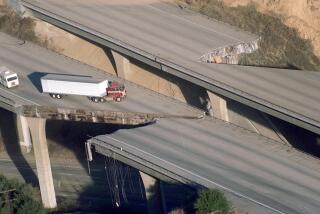Scientists to Place Observatories on Sea Floor
- Share via
SEATTLE — Scientists plan to create the first permanent observatories at some of the most forbidding and fascinating places on Earth: the sea floor volcanoes and superheated vents more than a mile and a half below the surface of the north Pacific.
The National Science Foundation has agreed to long-term support of the observatories along the Juan de Fuca Ridge, an area of intense seismic activity 250 miles off the coasts of Washington state and Oregon, according to oceanographers at the University of Washington and six other institutions.
For the first time, scientists will be able to coordinate their studies of the ridge and its inhabitants, much the same way their landlocked colleagues do research at the volcano observatory at Mt. St. Helens in southwestern Washington.
“We can begin thinking, scientifically, in terms of life cycles of volcanic processes,” said University of Washington oceanography professor John Delaney. “If there is an eruption, we can follow the eruption and the products of the eruption to its completion.”
*
The ridge is the boundary between two of the great plates that make up the Earth’s surface--the Pacific Plate to the west and the Juan de Fuca Plate to the east. New sea floor is created as the plates slowly move apart and magma from deep in the earth rises to fill the openings.
It’s a region of frequent earthquakes and volcanic eruptions, eerie mineral formations and life forms vastly different from those found elsewhere on the planet.
Seawater percolates down into the Earth’s crust along the ridge and becomes superheated to 660 degrees Fahrenheit and charged with minerals. The hot water returns to the ocean through sea floor vents, where the minerals precipitate in the chill of the ocean depths, forming towering pillars, some as tall as 13-story buildings.
The vents are home to bacteria that thrive on high temperatures and chemicals that are poisonous to most living creatures. The bacteria, in turn, feed lush colonies of worms, clams and other sea life on a sea floor once thought to be sterile.
In recent years, scientists have speculated that the first life on the planet may have originated at submarine volcanoes and that a similar process might occur on other planets.
In the past, scientists have been able to make only scattered expeditions to the ridge because of limited access to submarines capable of making the deep dives. Also, each expedition usually was separately funded, with little or no coordination among the geologists, volcanologists, marine biologists, oceanographers and other scientists interested in the site.
*
Under the Ridge Inter-Disciplinary Global Experiments program, scientists plan to set out a network of monitors and instruments to collect information, similar to the network of instruments that ring Mt. St. Helens. Unmanned vehicles eventually may be stationed near the ridge to collect samples or make observations, and the sensors may one day be linked to shore labs by underwater cable or satellite relays.
Such tools, along with a program of regular visits by surface research ships and manned submersibles, will let scientists study how the ridge and the life supported by the undersea vents change over long periods of time.
“In general, what’s important here is the long-term commitment and continuity we’ve got here,” Delaney said. “That means we can expect to go back year after year after year.”
Delaney said he anticipates the National Science Foundation will grant about $2 million a year for RIDGE projects, for a minimum of five to eight years. Researchers now are writing proposals to compete for the money.
New research projects will get underway this year and should be at full speed by 1997, Delaney said. It probably will take about five years for the observatory network to be deployed.
The program will concentrate on two sites: the volcanically active Endeavor segment, which is about 300 miles due west of Everett, and the Cleft segment, home to a number of strong hydrothermal vents about 250 miles west of Newport, Ore.
Among the questions scientists hope to answer are how often and how large the volcanic eruptions are and whether they form a pattern; how magma moves from the Earth’s upper crust to the sea floor; how biological communities develop and change around the vents and beneath the sea floor; and how the vents affect the ocean itself.






